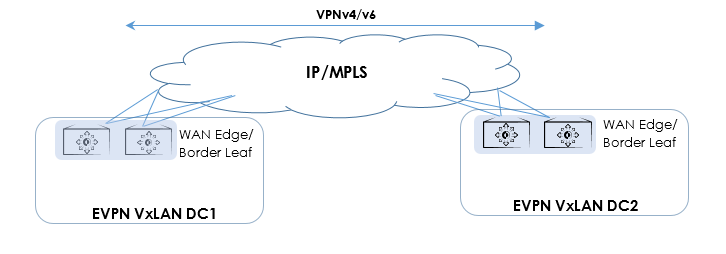BGP Unified Routing (EVPN-VPNv4/VPNv6 Interconnect)
EVPN VXLAN tunnels within the data center are terminated on the WAN edge. In BGP control plane, Type-5 prefix routes are imported from EVPN VXLAN peers and are re-originated towards BGP L3VPN peers as VPNv4/VPNv6 routes with associated MPLS labels.
Similarly, in the other direction, VPNv4/VPNv6 routes are imported from BGP L3VPN peers and are re-originated as EVPN Type-5 prefix routes towards EVPN VXLAN peers within the data center.
The existing interconnect solution is based on Layer 3 handoff which required two separate entities on each side of the EVPN VXLAN DC network. These entities are:
-
A Border Leaf that terminates VXLAN encapsulation from EVPN fabric and hands over Layer-3 routed packets to the WAN Edge.
-
A WAN Edge that acts as a L3VPN Provider Edge (PE) router that does the label-switching in the WAN/MPLS core.
The new design collapses the functions of the WAN Edge into the Border Leaf device thereby allowing VXLAN and MPLS to interwork on the same physical entity.
At the local BL (DC1 BL in the figure below) node, EVPN learned type-5 prefix routes in the fabric are imported into the local IP VRF routing table with the next-hop pointing to the EVPN L3VNI. These imported routes are in turn re-originated to the remote BLs as Layer 3 VPN NLRI with associated MPLS label(s).
At the remote BL node(DC2 BL in the figure below), routes learned through Layer 3 VPN are imported into its IP VRF routing table with the next-hop pointing to the MPLS tunnel towards its remote BL (which is the local BL). These imported routes are then re-originated into the remote BL's (DC2 BL) EVPN routing table and are advertised towards its (DC2 BL) spines as EVPN type-5 prefix routes with EVPN L3VNI associated with the IP VRF.


